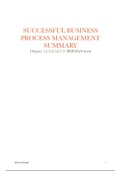Samenvatting
BPS SUMMARY CHAPTER: 1-8 11
- Vak
- Business Plan
- Instelling
- Hanzehogeschool Groningen (Hanze)
Successful Business Process Management: What You Need to Know to Get Results SUCCESSFUL BUSINESS PROCESS MANAGEMENT SUMMARY Chapter 1,2,3,4,5,6,7,11 BERMAN-book
[Meer zien]





